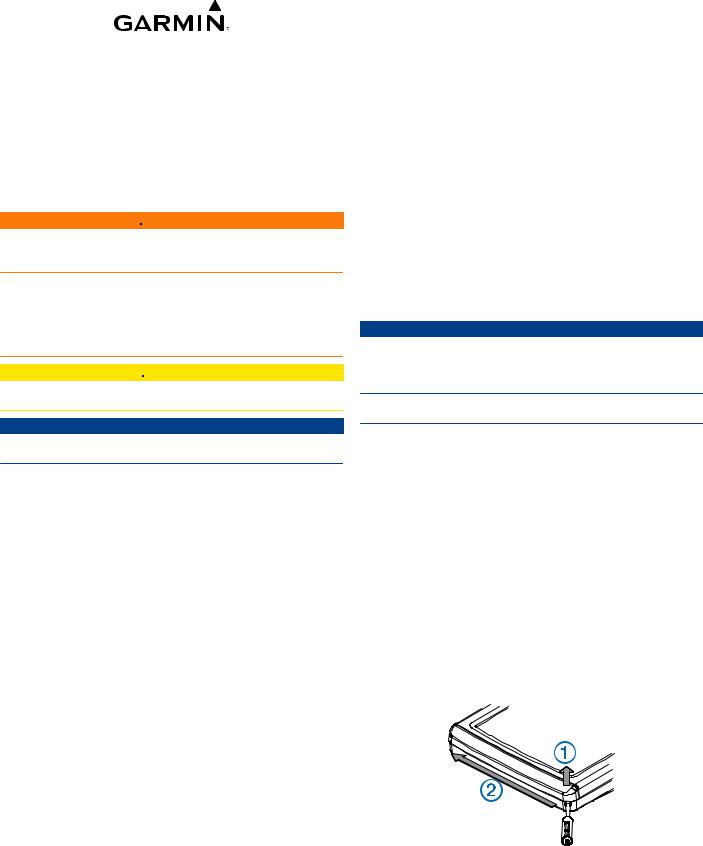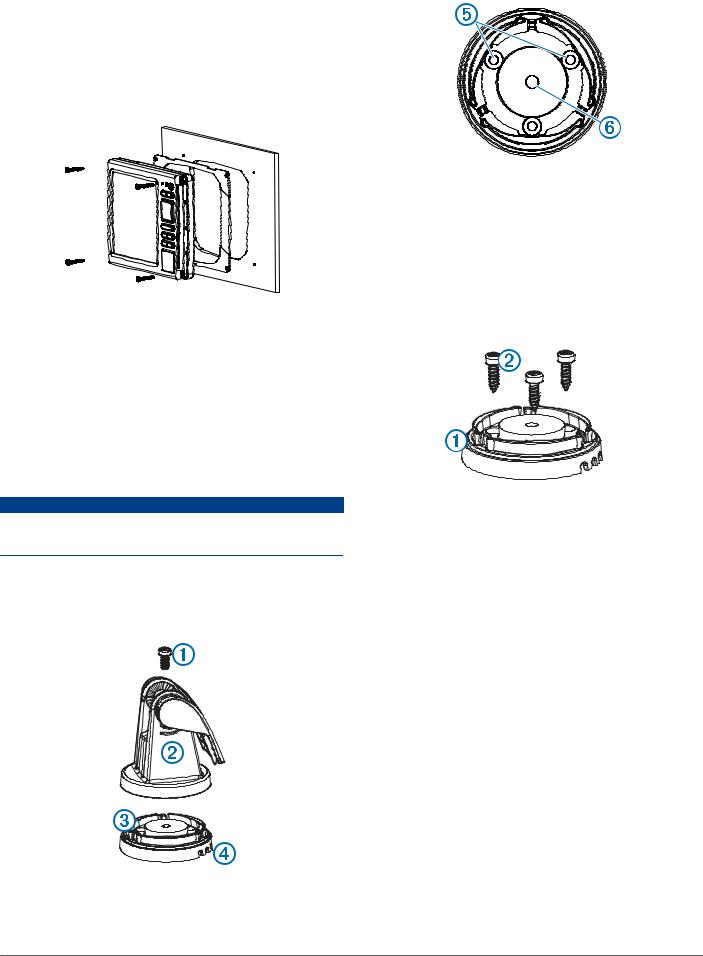Garmin echoMAP 42dv, echoMAP 43dv, echoMAP 44dv, echoMAP 45dv, echoMAP 52dv Installation Instructions
...
echoMAP™ 40/50 Series Installation Instructions
To obtain the best performance and to avoid damage to your boat, install the device according to these instructions.
Read all installation instructions before proceeding with the installation. If you experience difficulty during the installation, contact Garmin® Product Support.
Important Safety Information
 WARNING
WARNING
See the Important Safety and Product Information guide in the product box for product warnings and other important information.
When connecting the power cable, do not remove the in-line fuse holder. To prevent the possibility of injury or product damage caused by fire or overheating, the appropriate fuse must be in place as indicated in the product specifications. In addition, connecting the power cable without the appropriate fuse in place voids the product warranty.
 CAUTION
CAUTION
Always wear safety goggles, ear protection, and a dust mask when drilling, cutting, or sanding.
NOTICE
When drilling or cutting, always check what is on the opposite side of the surface.
To obtain the best performance and to avoid damage to your boat, install the device according to these instructions.
Read all installation instructions before proceeding with the installation. If you experience difficulty during the installation, contact Garmin Product Support.
Registering Your Device
Help us better support you by completing our online registration today.
•Go to http://my.garmin.com.
•Keep the original sales receipt, or a photocopy, in a safe place.
Contacting Garmin Product Support
•Go to www.garmin.com/support for in-country support information.
•In the USA, call 913-397-8200 or 1-800-800-1020.
•In the UK, call 0808 238 0000.
•In Europe, call +44 (0) 870 850 1241.
Tools Needed
•Drill and drill bits
•#2 Phillips screwdriver
•Marine sealant
•3/8 in. wrench or socket
•Masking tape
•Hardware for the swivel mount (not included)
◦Self-tapping, pan-head wood screws or pan-head bolts, either size #8 or a diameter of 5/32 in. (4 mm)
◦Appropriate washers and nuts (if selecting bolts)
◦Appropriate drill bit for drilling the pilot hole
Mounting Considerations
The device can be mounted using the included bracket, or it can be mounted flush with the dashboard using a flush-mount kit (may be sold separately).
Before permanently installing any part of your device, you should plan the installation by determining the location of the various components.
•The mounting location must provide a clear view of the screen and access to the keys on the device.
•The mounting location must be sturdy enough to support the device and the mount.
•The cables must be long enough to connect the components to each other and to power.
•The cables can be routed under the bail mount or behind the device.
•To avoid interference with a magnetic compass, the device should not be installed closer to a compass than the compass-safe distance value listed in the product specifications.
Flush Mounting the Device
NOTICE
Be careful when cutting the hole to flush mount the device. There is only a small amount of clearance between the case and the mounting holes, and cutting the hole too large could compromise the stability of the device after it is mounted.
Using a metal pry tool such as a screwdriver can damage the trim caps and the device. Use a plastic pry tool when possible.
A flush-mount template and hardware can be used to mount the device in your dashboard.
1Trim the template and make sure it fits in the location where you want to mount the device.
2 Secure the template to the selected mounting location.
3Using a 9.5 mm (3/8 in.) drill bit, drill one or more of the holes inside the corners of the solid line on the template to prepare the mounting surface for cutting.
4Using a jigsaw or rotary cutting tool, cut the mounting surface along the inside of the solid line indicated on the template.
5 Place the device into the cutout to test the fit.
6If necessary, use a file and sandpaper to refine the size of the hole.
7NOTE: Not all devices have trim caps.
Using a pry tool such as a flat piece of plastic or a screwdriver, carefully pry up the corners of the trim caps
À
and slide the pry tool to the center to remove the trim caps.
Á
8Ensure the mounting holes on the device line up with the pilot holes on the template.
9If the mounting holes on the device do not line up, mark the new pilot-hole locations.
10Using a 3.2 mm (1/8 in.) drill bit, drill the pilot holes. 11Remove the template from the mounting surface.
December 2014 |
Printed in Taiwan |
190-01834-02_0B |

12If you will not have access to the back of the device after you mount it, connect all necessary cables to the device before placing it into the cutout.
NOTE: To prevent corrosion of the metal contacts, cover unused connectors with weather caps.
13Install the rubber gasket pieces on the back of the device.
The pieces of the rubber gasket have adhesive on the back. Make sure you remove the protective liner before installing them on the device.
14Place the device into the cradle.
15Securely connect each cable to a port on the cradle. 16Place the locking bracket over the cables.
17Place the device into the cutout.
18Secure the device to the mounting surface using the included screws.
19Install the trim caps by snapping them in place around the edges of the device.
Installing the Swivel Base
Preparing to Run Cables under the Mounting Surface
NOTICE
Use pan-head screws or bolts when securing the swivel-mount base. Screws or bolts with countersunk heads damage the base.
Before you can prepare the swivel-mount base, you must choose the location to install the mount and decide whether to attach the mount using screws or bolts.
1 Remove the 10 mm M6x1 Phillips screw and separate the
À
swivel mount from the base .
ÁÂ
2 Orient the swivel base so the pass-through holes face the
Ã
desired direction.
3 Using the swivel base as a template, mark the pilot hole locations .
Ä
4 Mark the cable routing hole .
Å
5Using the appropriate drill bit for the hardware, drill the three pilot holes.
6Using a 5/8 in. (16 mm) drill, drill a hole through the mounting surface at the location you marked in step 4.
Fastening the Swivel Mount without the Cables Running through the Mount
You should complete this procedure only if you are not running the power and transducer cables under the mounting surface and through the swivel-mount base.
1 Place the base on the mounting surface, and fasten it
À
using the appropriate screws or bolts .
Á
2Place the swivel mount on the base, and replace the 10 mm M6×1 Phillips screw.
3 Seal the cable pass-through holes with marine sealant.
Fastening the Swivel Mount with the Cables Running through the Mount
You should complete this procedure only when running the power and transducer cables under the mounting surface and through the swivel-mount base.
1Feed the cables through the 16 mm (5/8 in.) center hole you drilled when preparing to run cables beneath the mounting surface.
2 Place the base on the mounting surface.
3 Route the cables through the cable pass-through holes.
4Loosely fasten the base using the appropriate screws or bolts.
5 Place the swivel mount on the base, but do not fasten it.
6Place the cradle or device into the swivel mount (Installing the Device in the Cradle).
7Pull out enough slack from the power and transducer cables so the mount can fully swivel to the desired positions when the cables are connected.
8 Remove the cradle and the swivel mount from the base.
9Apply marine sealant to the 16 mm (5/8 in.) center hole and to the cable pass-through holes.
10Securely fasten the base with the appropriate screws or bolts.
11Place the swivel mount on the base, and fasten it using the included 10 mm M6×1 Phillips screw.
2
